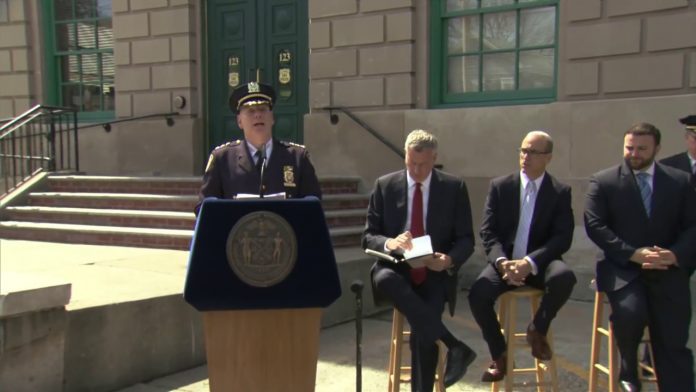
NEW YORK—Mayor Bill de Blasio and Chief of Patrol Terrence Monahan today announced figures from a preliminary progress report on citywide neighborhood policing efforts at the 123rd police precinct in the Tottenville neighborhood of Staten Island. The 123rd precinct is the latest command set to become a Neighborhood Policing Command (NPC).
“Neighborhood policing has ushered in a new era of law enforcement built on mutual trust, understanding and cooperation. When New Yorkers know their local officers and trust their local officers, we are all safer as a city. Coupled with the retraining of the entire department and the introduction of body cameras, we’re giving officers the tools they need to do their jobs effectively and strengthening the bonds between police and community to make the safest city in the nation even safer,” said Mayor de Blasio.
“It’s a great day for the South Shore of Staten Island, as we introduce Neighborhood Policing to the 123 Precinct,” said Police Commissioner James P. O’Neill. “In addition, the release of this report demonstrates the substantial progress we have made in reducing crime and building trust in neighborhood policing commands. This new philosophy will enable us, by working collectively with the public, to further reduce crime and keep New York the safest city in America.”
In May 2015, the de Blasio Administration and the New York City Police Department began the next phase in making the safest big city in America even safer by introducing a new way of fighting crime: neighborhood policing.
Neighborhood policing is now in place in more than fifty percent of the city’s precincts. In those precincts, the sectors – zones where police officers are assigned – have been re-drawn to reflect natural neighborhood borders. Officers are assigned week after week to the same sectors on the same shifts. When officers are consistently assigned to the same sector, they develop a profound understanding of the community they serve: the people, the problems, and the persistent issues. In addition to the officers assigned to patrol, each sector has two Neighborhood Coordination Officers (NCOs), whose entire focus is on learning the neighborhood and advising the officers on patrol. All of that means more officers and sector cars are available to respond to calls from the public than at any time before.
The preliminary results are in: Neighborhood policing works.
The Model
The neighborhood policing philosophy is based on the simple concept that communities and cops will be safer if they know and trust each other. Each neighborhood policing command, comprised of three to five sectors, has two specifically trained NCOs assigned to each sector.
NCOs spend time in the community, building relationships, understanding the issues, handing out cards and phone numbers, and getting to know as many people as they can. Over time, they develop a granular sense of where crimes are being committed and who is committing them. As the officers deepen relationships and build trust with residents, the public begins to know the officers, coming to them with concerns, often allowing the NYPD to prevent crime before it occurs.
Precincts with NCO commands are carefully re-drawn, so the sectors reflect the neighborhood, with dedicated patrol officers assigned to the same sectors on the same shifts. With more police officers responding to calls in their sectors, NCOs are able to engage in long-term crime fighting strategies. They use time away from the radio to follow-up on recurring crime or quality of life issues, attend community meetings, and visit with residents or business owners in the neighborhood.
Recently, in the north Bronx in the 52nd Precinct, the NCOs met with residents who told them about a series of car break-ins occurring on a residential block. The NCOs worked with detectives in the command, analyzed the historical data on the car break-ins and were able to pinpoint the precise time, day, and location where the break-ins were most likely to occur next. The NCOs shared this intelligence with officers working the midnight shift. The NCOs changed their tours and, with the sector officers, conducted directed patrols in the area. During a directed patrol, the NCOs and sector cops observed a suspicious male and carefully followed him until he committed a car break-in. After a foot pursuit, the suspect was caught. Later, detectives would tie the same suspect to five other break-ins.
A Big Change
Neighborhood policing represents a fundamental change in how the NYPD operates.
In the past, officers concentrated on specific types of crime, or responded to a backlog of 911 calls. With re-drawn sectors and more officers on patrol to answer radio runs, coupled with the training they need to successfully handle most situations, NCOs can take a holistic approach to the crime and conditions a community faces. Before neighborhood policing, officers on patrol typically would not have the time or training to address many problems neighborhoods face. Today, NCOs have the know-how to work with other agencies and engage in advanced problem solving.
For example, in October 2016, Neighborhood Coordination Officers from the 120th precinct on the North Shore of Staten Island collaborated with the Department of Buildings and a local bank to move squatters out of an unoccupied building owned by that bank. The NYPD secured the building, prevented future squatting, and addressed a long-standing quality of life condition for nearby residents. All of this was made possible by the advanced training NCOs receive and by the time they take to work with the neighborhood to identify and solve local problems.

